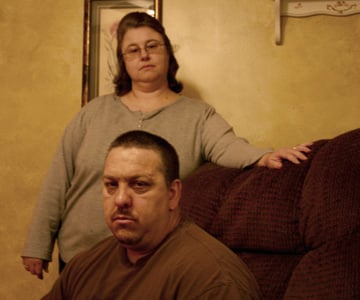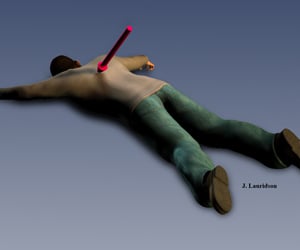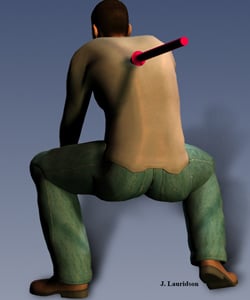Federal agents have broadened their investigation of the New Orleans Police Department and are now looking into three post-Katrina police shootings detailed in a news series published by ProPublica, The Times-Picayune and the PBS series "Frontline" in December.
Assistant Superintendent Marlon Defillo of the NOPD confirmed that the FBI has subpoenaed documents relating to the shootings -- which included police investigative reports, as well as other related files -- in the past two months.
Separately, two independent experts who reviewed the newly available autopsy report of Matthew McDonald, one of those shot, said it raised fresh questions about the shooting and its circumstances. One expert said the man, a 41-year-old drifter from Connecticut, may have been hit by the single round that killed him as he lay prone on the ground. The other expert criticized efforts to gather evidence, calling the New Orleans coroner's forensic work in the case "incomplete at best."
In the news series, "Law & Disorder," reporters at ProPublica, The Times-Picayune and PBS "Frontline" examined police conduct in the wake of Katrina. The series focused on three confrontations between police and civilians: the fatal shooting in Faubourg Marigny of McDonald, the 41-year-old drifter; the fatal shooting of an 45-year-old Danny Brumfield Sr. in front of the Ernest N. Morial Convention Center; and the nonfatal shooting of Keenon McCann on an Interstate 10 overpass.
Sheila Thorne, a special agent in the FBI's field office in New Orleans, confirmed that agents were "looking into the circumstances surrounding Matthew McDonald's death." She declined to discuss the other two shootings featured in the series.
Jim Gallagher, spokesman for the local Fraternal Order of Police lodge, said Thursday afternoon that he was unaware that the FBI probe had widened and that he was not in a position to comment.
The federal subpoenas are the latest development in the long-running investigation of the NOPD. For more than a year, agents have been examining two controversial post-Katrina episodes: the Danziger Bridge incident, during which officers killed two civilians and wounded four others; and the death of Henry Glover, who witnesses say died while in NOPD custody in Algiers. Federal investigators believe a police officer shot Glover, according to the officer's lawyer and other sources close to the probe.
DA Declines to Charge
Out of all of the police shooting cases examined in the news series, the McDonald case was perhaps the most mysterious.
Exactly when the NOPD concluded its own investigation into the McDonald shooting is unknown, as are the department's findings about the case. Police said in their initial report they could find no other witnesses to the incident.
The NOPD has repeatedly refused to provide reporters with the supplemental report by homicide detectives that determined whether or not the shooting was justified. City Attorney Penya Moses-Fields earlier this month stated in a letter that the report could not be released because the case is "the subject of an ongoing criminal investigation," although she did not explain which agency was investigating.
The Orleans Parish district attorney's files show the police documents on the case were turned over to the agency in May 2007, said Chris Bowman, communications director for the office. The DA's public corruption unit, which at the time looked at every officer-involved shooting, reviewed the case and decided in September 2007 that criminal charges were not warranted, he said.
"It was refused because there was no evidence that was contrary to what the police said happened," Bowman said.
According to the NOPD's seven-page initial incident report, Lt. Bryant Wininger confronted McDonald on the afternoon of Sept. 3, 2005, because he was clutching a white plastic bag containing a handgun and a bottle.
McDonald was ordered by police to drop the bag, but he refused, instead reaching inside, according to the report. He then allegedly raised the bag toward Wininger, who fired his AR-15 assault rifle at McDonald as he began turning away, the report stated.
After again ordering McDonald to drop the gun, Wininger fired a second shot, and McDonald fell to the ground, the report said.
Wininger has declined to comment on the shooting. The day of the shooting, he was patrolling in a white pickup truck with three other officers: Det. Nicholas Gernon, Sgt. Daniel Scanlan and officer Nick Pearson. NOPD officers are barred, by agency policy, from speaking to the media.
'Swept Him Under the Carpet'
 A hard-drinking drifter from the Northeast, McDonald left behind family members and a girlfriend in Norwich, Conn. McDonald's relatives didn't know he'd been slain by an officer until they were contacted by a reporter in late 2009.
A hard-drinking drifter from the Northeast, McDonald left behind family members and a girlfriend in Norwich, Conn. McDonald's relatives didn't know he'd been slain by an officer until they were contacted by a reporter in late 2009.
His sister-in-law, Kerry McDonald, said the police department "led us to believe it was a civilian" who killed McDonald. In her view, the NOPD "just swept him under the carpet like he was discarded garbage and nobody cared about him, which was not true."
A friend of McDonald's who met the Connecticut native on the streets before Katrina and hung out with him after the storm said he doesn't recall his friend ever carrying a gun.
Mike Perez, a frequently homeless man who contacted reporters after the initial story appeared in December, said the two men spent the days after the storm looking for places to crash and alcohol to drink. During their time together, he never spotted the 9mm handgun that police reported taking from McDonald after he was shot.
Perez, however, remembered his friend picking a white plastic bag out of a trash can that morning to hold beer and water bottles.
The two men had been drinking beer in the French Quarter just hours before McDonald was shot, Perez said. Perez, who was waiting for his brother to arrive to drive him to Baton Rouge, invited McDonald to come along.
McDonald agreed but said he needed to try to get some money from a friend first, heading off toward Rampart Street, he said. McDonald never returned, and when Perez's brother arrived, he left.
Autopsy Report Analyzed
As federal agents begin looking at the McDonald killing, one key piece of evidence has recently resurfaced.
In December, the coroner's chief investigator, John Gagliano, told reporters the McDonald autopsy had been misplaced and could not be found.
After the stories appeared, a CNN producer who'd obtained that document several years ago provided it to reporters.
The six-page autopsy report shows McDonald was slain by "one penetrating gunshot wound" to the left back, which broke ribs, punctured a lung and caused internal bleeding. Tracing an upward trajectory, the bullet moved from "bottom-to-top" as it tore through the man's body, according to the autopsy.
 Two independent experts reviewed the autopsy and available police documents at the request of reporters and focused on the angle of the fatal shot.
Two independent experts reviewed the autopsy and available police documents at the request of reporters and focused on the angle of the fatal shot.
James Lauridson, a forensic pathologist and former chief medical examiner for the Alabama Department of Forensic Sciences, said he was able to draw some conclusions about the circumstances of the shooting from the documents. He saw two likely possibilities.
McDonald was "possibly crouched down in a protective manner" when Wininger fired, said Lauridson. "The other alternative is that he was flat on his face."
The police report is thin on details, but it suggests Wininger fired the fatal shot as McDonald was standing and trying to pivot away from the gunfire. According to the NOPD report, Wininger took two more shots at McDonald as he lay on the pavement after he allegedly continued reaching for the gun in the white bag. Neither of those shots "appeared to have wounded him," the report stated.
In Lauridson's opinion, the possible discrepancies between how the police report describes the shooting and the autopsy findings are understandable. In a shooting situation, he noted, emotions run extremely high, and the people involved often have trouble accurately remembering all the details.
 Louis Levy, who worked as a forensic pathologist for several North Carolina counties, also studied the autopsy and police report. Levy, who now performs autopsies for private clients, thinks McDonald "could've been standing up, but leaning forward as if he was going to dash away from the police" when he was shot. He didn't think McDonald was shot while lying down.
Louis Levy, who worked as a forensic pathologist for several North Carolina counties, also studied the autopsy and police report. Levy, who now performs autopsies for private clients, thinks McDonald "could've been standing up, but leaning forward as if he was going to dash away from the police" when he was shot. He didn't think McDonald was shot while lying down.
However, Levy said it was hard to be certain because the forensic work was "incomplete at best." He faulted the Orleans Parish coroner's office for failing to collect the bullet -- or bullet fragments -- and McDonald's clothes from West Jefferson Medical Center, where police state in their report they took McDonald after he was shot.
The garments, Levy explained, could have been stained with gunshot residue, which would offer clues about the distance between McDonald and Wininger when the shot was fired.
Coroner Declines to Comment
The autopsy, conducted by pathologist Samantha Huber, noted the body was inside a body bag on a blood-soaked green sheet. No clothing was in the body bag received by the coroner's office, the report stated, which also noted that "no projectile" was present in the body.
The report did not state how the coroner's office received the body.
Minyard declined to comment on Thursday, saying he would need to review the autopsy and could not talk until Monday.
But the longtime Orleans Parish coroner has often discussed the gruesome and difficult conditions that faced his team of forensic pathologists after Katrina. With the New Orleans morgue flooded, doctors dissected more than a thousand bodies in makeshift forensic centers in oppressive heat with inadequate resources.
Many bodies were seriously decomposed because they were left out in the heat, but that doesn't appear to be the situation with McDonald.
The autopsy was conducted on Sept. 13, according to the report, which noted the body was "slightly cool to the touch due to prior refrigeration." The report found "minimal rigidity."
For McDonald's loved ones, the autopsy hasn't diminished their skepticism about his death. John McDonald doesn't believe his brother would have disobeyed commands coming from a police officer aiming an assault rifle in his direction. "Matt would've put his arms up and said, 'All right, you got me.' He would've laid down," John McDonald said. "He would've laid down."
Tom Jennings of "Frontline" contributed to this report.


